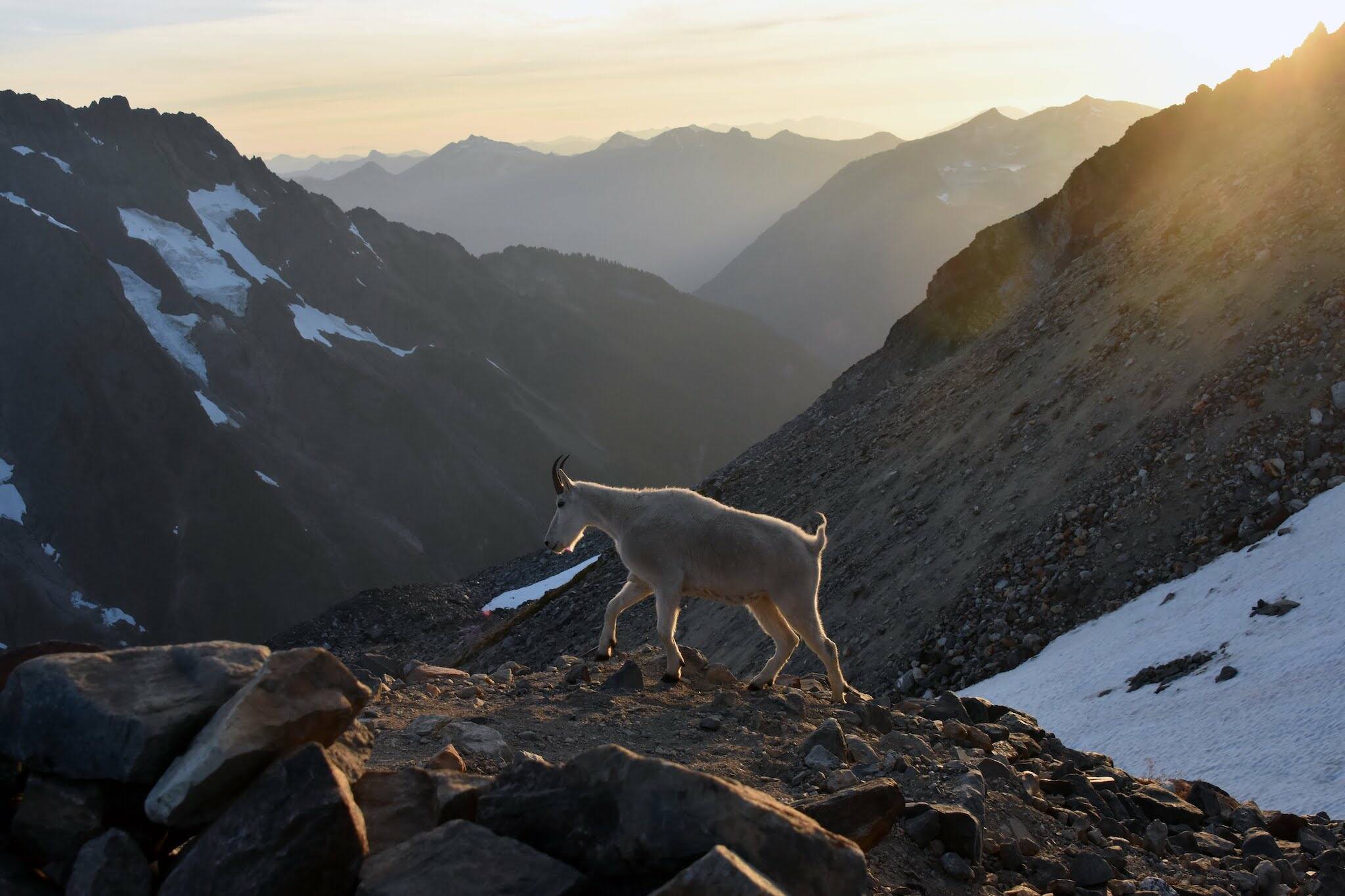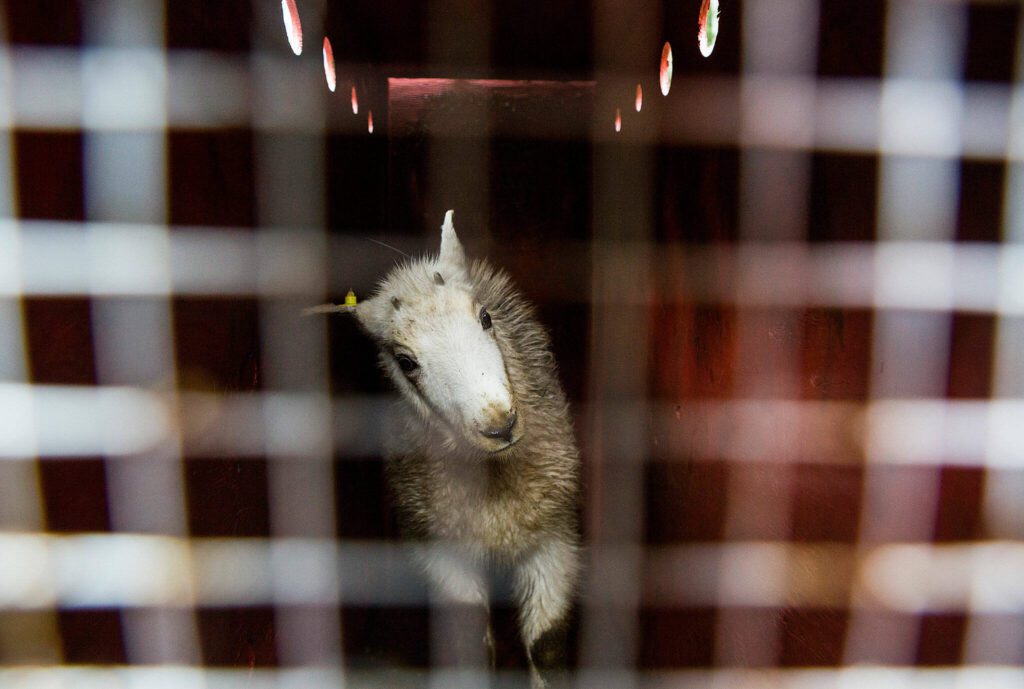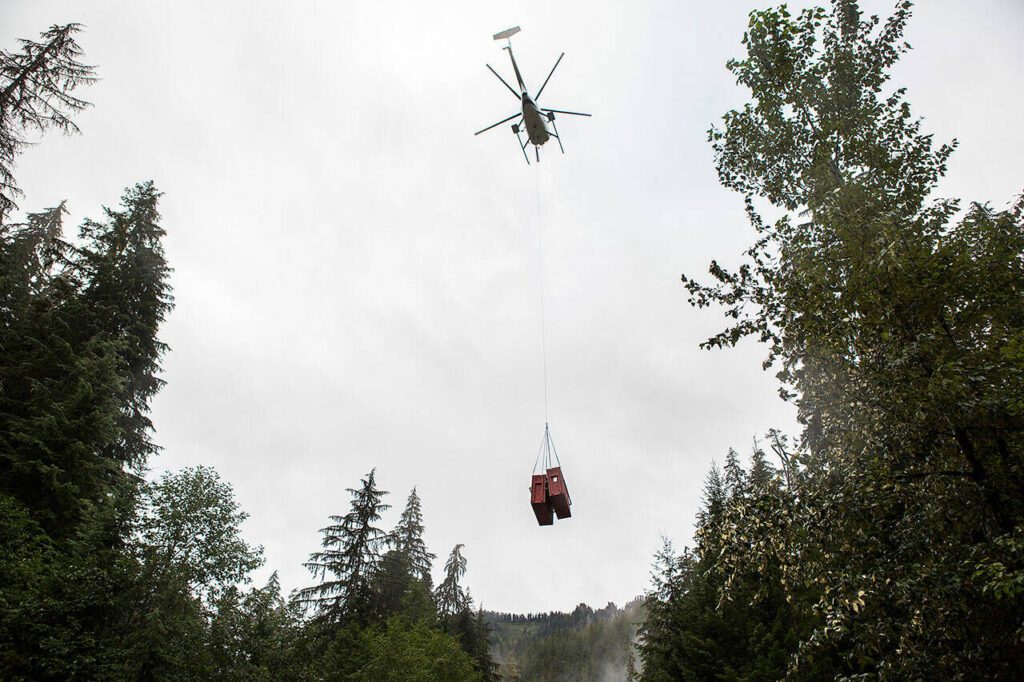DARRINGTON — About five years ago, wildlife biologists with the Tulalip Tribes used GPS collars to start tracking 115 mountain goats translocated from the Olympic Peninsula to the North Cascades.
Only three are still alive today.
Wildlife biologists with the Stillaguamish Tribe found similar results. Out of 36 translocated goats they tracked, only one is still alive. Usually, mountain goats live between 10 to 13 years in the wild.
“It was really a red-flag moment for the tribes,” said Mike Sevigny, wildlife manager with the Tulalip Tribes.
In 2020, local tribes, the National Park Service, state Department of Fish and Wildlife and U.S. Forest Service finished transferring hundreds of mountain goats via truck and helicopter to the North Cascades. The purpose of the three-year project was twofold: to remove non-native goats from the Olympic Peninsula and potentially boost the animal’s population in northern Washington.
At the same time, biologists noticed goats native to the North Cascades were also dying at an alarming rate. In 2017, biologists with the Tulalip Tribes counted 145 mountain goats near Whitehorse and Three Fingers mountains — where they tend to roam in large numbers. Last year, the biologists counted eight near the two peaks.
Mountain goat experts are unsure about the exact cause of the decline, though they have multiple theories. Recreation, habitat loss, climate change, disease and predation are among them.
Over the next three years, the Tulalip and Stillaguamish tribes plan to monitor North Cascades mountain goats using new methods. Instead of GPS collars, biologists will use camera traps — a camera that takes pictures whenever it senses movement — as well as thermal imaging drones and other noninvasive monitoring methods.
This year, the Stillaguamish Tribe will receive $195,656 from the national Tribal Climate Resilience Annual Awards Program. The tribe will use the money to partner with the Tulalip Tribes and Lummi Nation in goat-monitoring efforts.
“We can’t really afford to lose one goat at this point,” said Jennifer Sevigny, wildlife program manager with the Stillaguamish Tribe.
Soon, federal officials will undertake another hefty, high-stakes relocation effort to the North Cascades — this time with grizzly bears.
‘Part of their culture’
Over 10,000 goats lived in Washington as recently as 1961, according to the state Department of Fish and Wildlife. Now, an estimated 2,400 to 3,200 remain.
Historically, mountain goats were an important food, cultural and spiritual resource for tribes.
Specific families captured the goats to bring them back to the tribes, said Aaron Jones, interim natural and cultural resources director with the Tulalip Tribes.
Mountain goat wool is especially warm, allowing tribal members to make blankets and vests.
But in 1855, ancestors of the Tulalip and Stillaguamish tribes were among those to sign the Treaty of Point Elliott, ceding millions of acres of ancestral lands in exchange for a small amount of money and U.S. government protection.
“We were displaced from the areas we were managing as families and tribes,” Jones said.
It has been decades since the Stillaguamish Tribe has hunted goats, said Jennifer Sevigny. The Tulalip Tribes harvested one goat three years ago, though Mike Sevigny with the Tulalip Tribes estimates that was the only goat the tribes harvested in over a decade.
“That’s part of their culture that they’re not able to exercise,” said Amanda Summers, a wildlife biologist for the Stillaguamish Tribe.
Washington residents who receive a special permit on a lottery basis are able to hunt mountain goats in specific areas. Not all state mountain goat populations are declining, said William Moore, ungulate specialist (primarily focusing on hoofed mammals) with Washington Fish and Wildlife.
The population near Mount St. Helens has soared over the past decade. In 2014, biologists counted 65 goats and now estimate some 400 goats live there.
Before 2018, mountain goats thrived on the Olympic Peninsula, too.
‘Some species translocate very well’
Researchers believe hunters initially introduced a handful of mountain goats to the Olympic mountains in the 1920s, before Olympic National Park was established.
The population on the peninsula skyrocketed about a century later to almost 700 goats.
Biologists also noticed the goats harmed local vegetation, as the animals ate and stomped on native plants. And in 2010, a mountain goat killed a national park visitor, raising safety concerns among Park Service staff.
State agencies decided to launch the mountain goat translocation effort in 2018 to eradicate the non-native species from the Olympics.
Agency staff used tranquilizer darts and net guns to capture 325 goats over the course of three years.
Then the animals were placed in crates and transported by truck and helicopter to Mount Baker-Snoqualmie and Okanogan-Wenatchee national forests.
“It was an enormous project to undertake,” said Moore, who assisted with the final year of translocation.
Between 2020 and 2021, volunteers and agency staff killed 152 mountain goats in the Olympics, a removal method outlined in the Park Service’s goat management plan.
Biologists expected lower survival rates among translocated goats, compared to resident goats, according to a 2023 article in The Wildlife Society. The goats were moved to a completely new area. They had to learn where to forage and avoid predators. Moore, of state Fish and Wildlife, said some of the translocated goats reproduced. Even so, the goats did not survive as well as biologists had hoped.
“Some species translocate very well,” Moore said, referencing bighorn sheep and elk specifically. “I think mountain goats are different than other ungulates.”
‘A complete ecosystem’
Biologists have historically used relocation to recover threatened species — grizzly bears among them.
Last week, the Park Service and U.S. Fish and Wildlife finalized their decision to relocate grizzly bears to the North Cascades in an effort to recover the animal’s population there.
In the 1800s, an estimated 50,000 grizzlies roamed throughout western North America. Now biologists consider the grizzly bear extinct in the North Cascades.
Federal agency staff will release three to seven bears every year, until there is a population of 25 grizzlies. The agencies expect to release 11 more bears after that, with the hope the population could reach 200 in a century.
Between 1990 and 2018, wildlife officials also captured 26 grizzly bears from British Columbia and released them in the Cabinet Mountains of northwestern Montana. An estimated 15 grizzly bears lived in the Cabinet-Yaak Ecosystem before relocation efforts started. Now, there are 60 to 65 bears.
Biologists aren’t concerned about relocated grizzlies further jeopardizing mountain goat populations in the North Cascades. And, biologists with the Tulalip Tribes are interested to see if recreation decreases once grizzlies are moved to Washington. Fewer hikers in mountain goat habitat could help.
“We want a complete ecosystem,” Mike Sevigny said. “Part of that had grizzlies in them.”
Some translocated mountain goat deaths were linked to capture- and transport-related stress, according to the Wildlife Society report. More frequent droughts and warm spring weather also likely contributed to native and non-native mountain goat declines, report authors said.
Wildlife biologists with the Tulalip and Stillaguamish tribes suspect recreation also has a significant effect on mountain goat numbers. This is a correlation they hope to explore more in future monitoring.
Mountain goats near popular trails, like the Enchantments southwest of Leavenworth, frequently encounter people.
But “not all goats are habituated to people,” said Dylan Collins, assistant wildlife biologist with the Tulalip Tribes.
Over the next two years, wildlife biologists with local tribes plan to draft specific actions that may help native mountain goat populations recover.
Collaboration among state agencies and local tribes can help, Jennifer Sevigny said.
“It’s unfortunate that we’re in this situation,” she said. “We all have to get together to figure out the best approach.”
Ta’Leah Van Sistine: 425-339-3460; taleah.vansistine@heraldnet.com; Twitter: @TaLeahRoseV.
Talk to us
> Give us your news tips.
> Send us a letter to the editor.
> More Herald contact information.




























